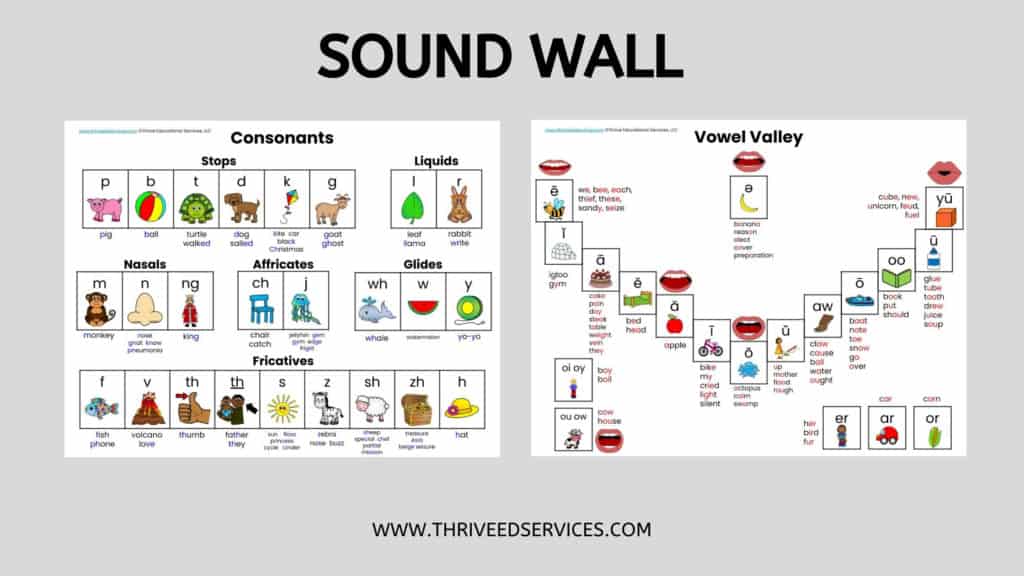Are you confused about how to divide words into syllables? Or maybe you’re not sure exactly how to teach your students the syllable division rules. It can be tricky, but with a few simple rules, you’ll be able to do it like a pro. In this blog post, we will discuss the most common ways to divide words into syllables, as well as provide some tips for making the process easier. So if you’re ready to learn more about breaking words into syllables, keep reading!
Why Syllable Division Is Helpful
By knowing how to split words into syllables, students can chunk up bigger words into more manageable pieces. This helps them read longer and more difficult words, as well as unfamiliar words.
Dividing words into syllables also helps you figure out what the vowel sound will be. When students come across unfamiliar words, breaking them up into syllables can help them predict what the vowel sound will be based on the patterns they see in the words.
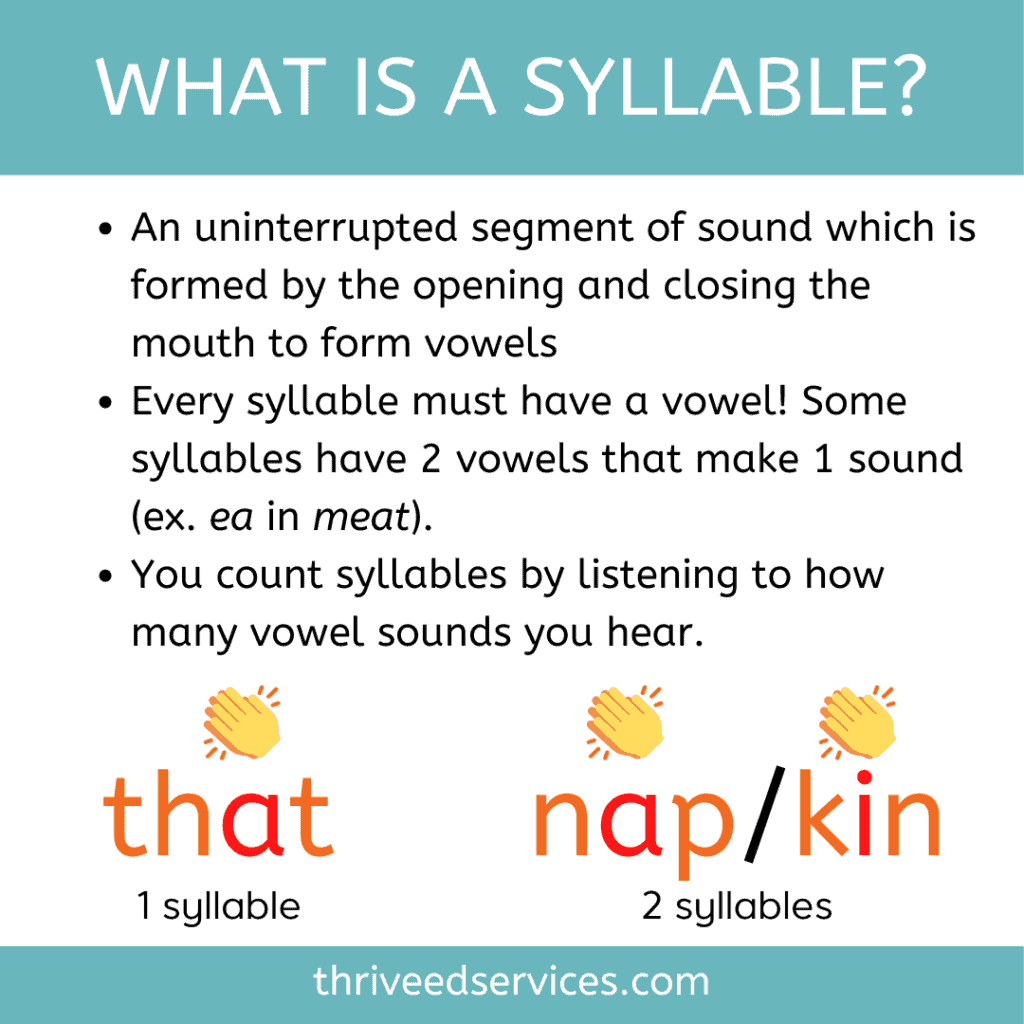
Syllabication Rules
There are several rules, or better yet patterns since there are always some exceptions, that can help with syllable division. Remember that there are 6 syllable types, but some words are only 1 syllable. Refer to my guide on the 6 syllable types for more on each.
The main thing to keep in mind when dividing words into syllables is that every syllable must have a vowel sound! We hear a vowel sound in every syllable, and sometimes it takes more than one vowel to make a vowel sound.
Here are the different rules to break words into syllables:
Rule 1: VC/CV – Split 2 consonants that are between vowels.
Whenever 2 consonants come together in a word, divide between them: VC/CV
The exceptions to this are to keep consonant digraphs (i.e. ch, ph, ck) and consonant blends (i.e. bl, st, fr) together.
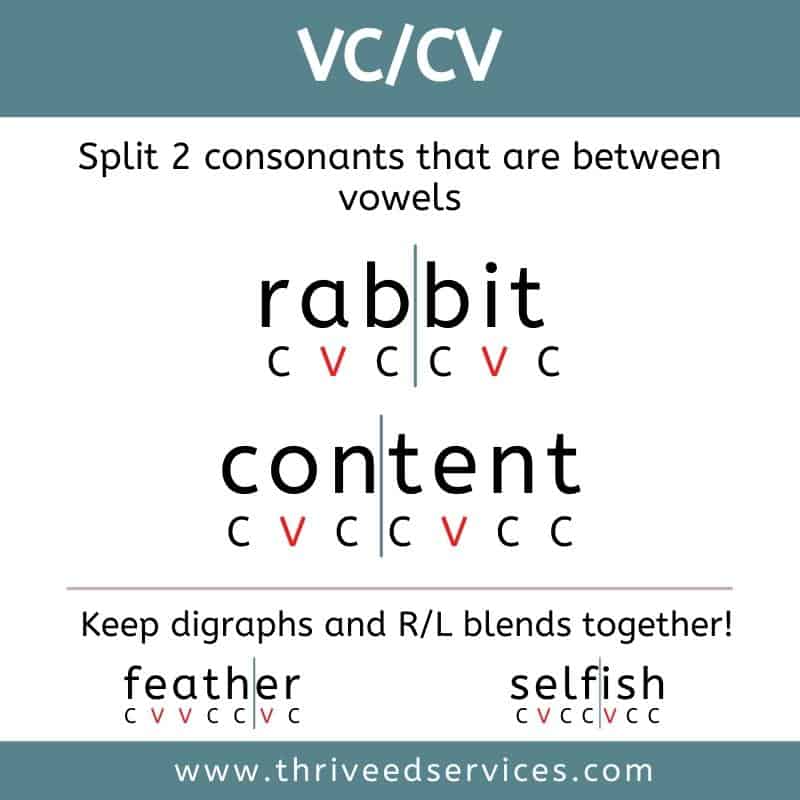
Check out my VCCV Syllable Division Worksheets if you’re looking for a ready made teaching resource.
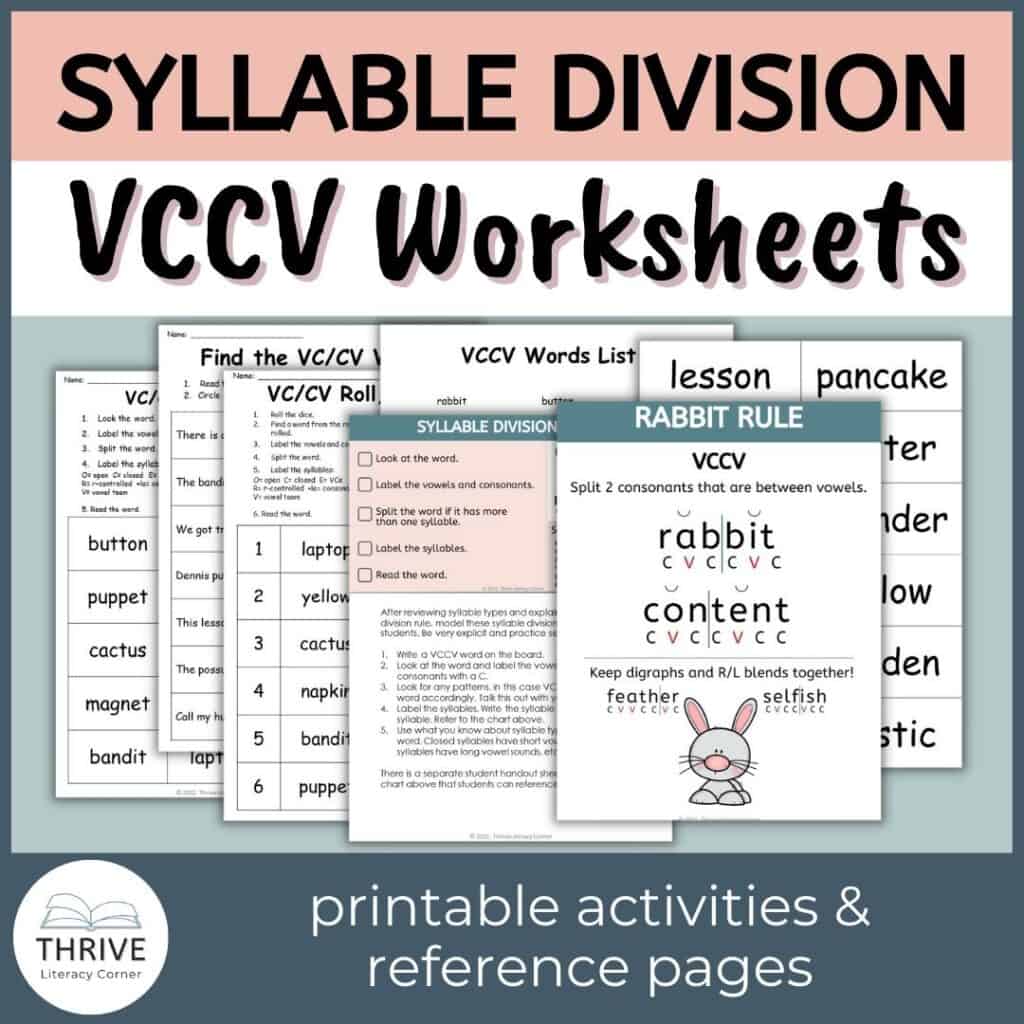
Rule 2: C+le – The ending -le usually takes the consonant before it to make one syllable.
When a word ends with a consonant and -le, divide it before the consonant so that the last syllable is C+le.
The silent e in C+le words helps add that vowel sound we need in every consonant. It’s one of the many jobs of silent e.
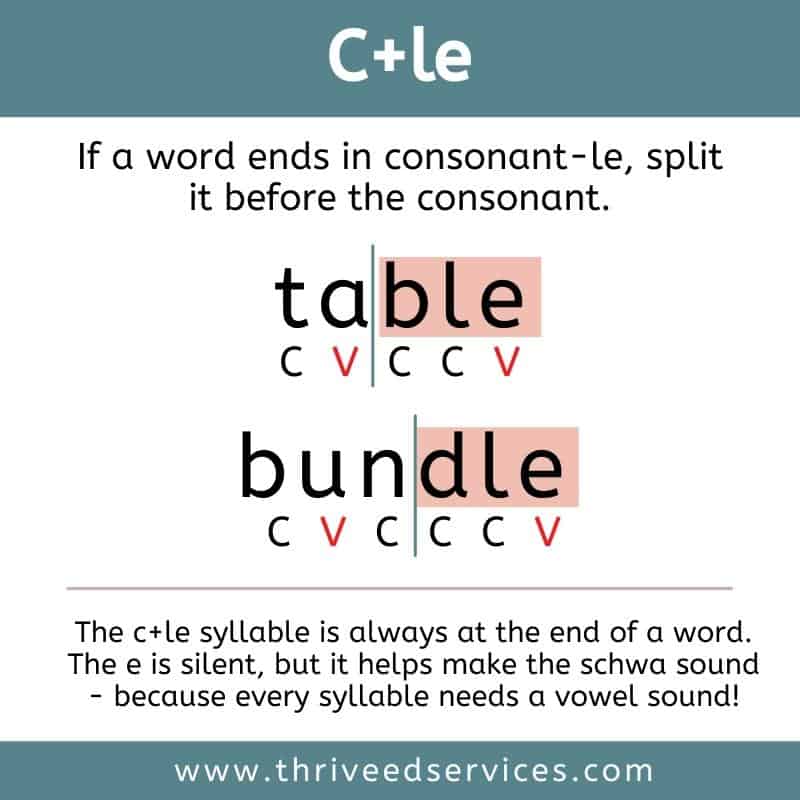
Check out my C+le Syllable Division Worksheets if you’re looking for a ready made teaching resource.

Rule 3: V/CV & VC/V – Split before or after a consonant that comes between 2 vowels.
When only one consonant comes between vowels, divide after the first vowel: V/CV. This makes the first syllable an open syllable, and it will have a long sound.
Pronounce the word with an open syllable. If this doesn’t make a word that sounds familiar, then divide after the consonant: VC/V. This makes the first syllable closed, so the vowel will say its short sound.
Because this one is not as predictable I teach it after VCCV and C+le. I typically start with V/CV only, then I teach VC/V. After this, I mix them up and teach students to be flexible, showing them how to try it as V/Cv first, then VC/V after.
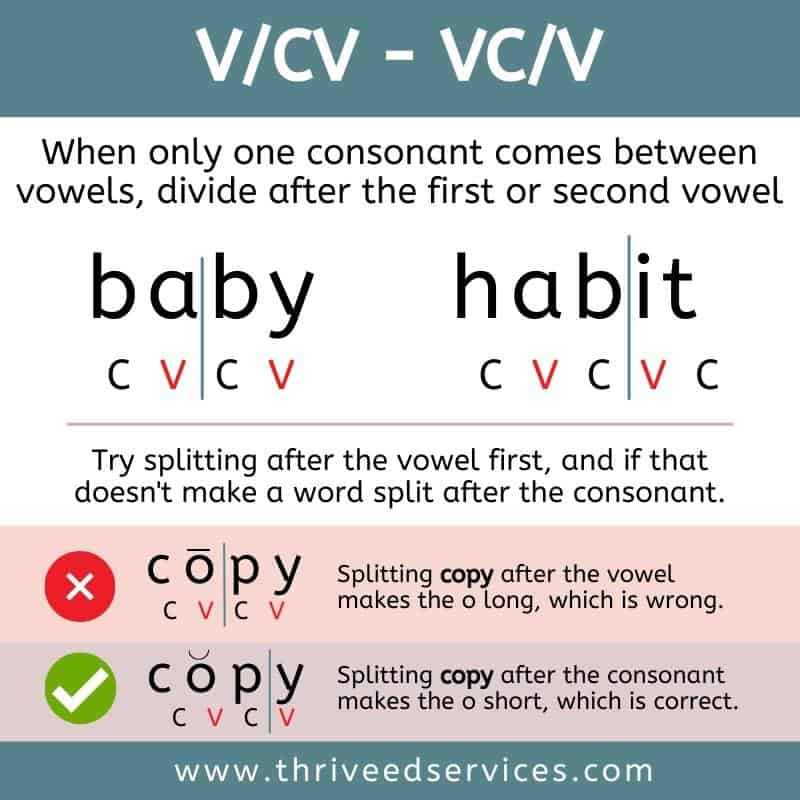
Check out my VC-V and V-CV syllable division worksheets if you’re looking for ready made teaching resources.
Rule 4: V/V – Split 2 vowels next to each other that do not work as a team.
If a vowel combination is in reverse, divide between the vowels: V/V. In this case, each vowel will have a sound.
It’s so important for students to know common vowel teams so they don’t split those up! If students are still learning basic vowel teams, wait to teach this syllable division pattern. Words like “beach” and “boat” have vowel teams that do not get split. These vowel teams work together to represent one vowel sound.

Rule 5: VC/CCV & VCC/CV – Split before or after the second consonant when 3 consonants come together.
When three consonants come together, divide after the first consonant: VC/CCV. If this doesn’t make a word that sounds familiar, divide after the second constant: VCC/CV.
These words often contain blends and digraphs, which if you recall, do not get broken up. When you see 3 or more consonants together, look for blends and digraphs to help determine where to split the word.
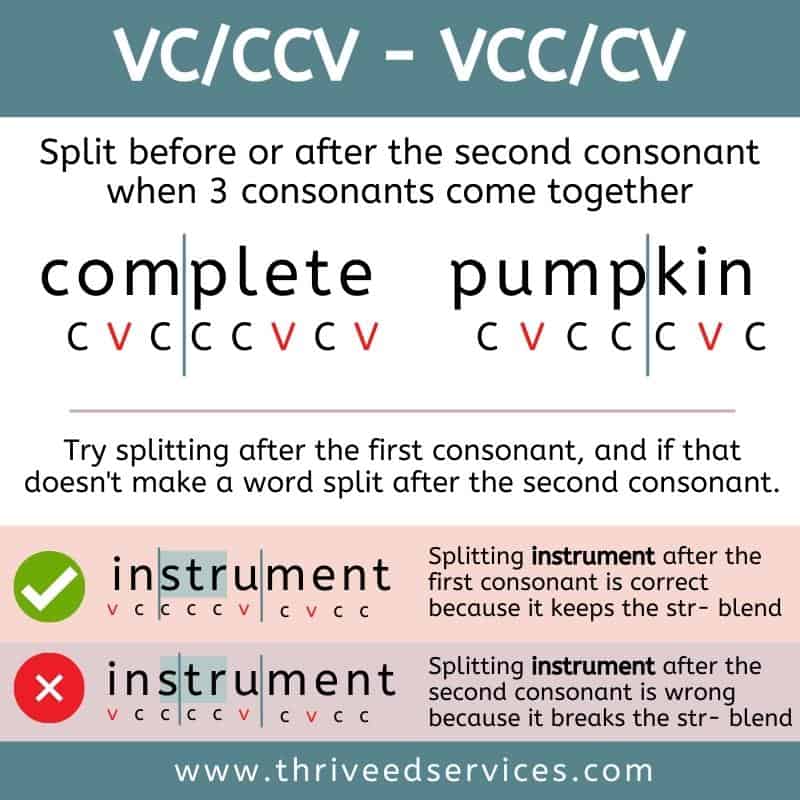
Rule 6: Divide after a prefix and before a suffix.
When you see a prefix, divide the word right after it. When you see a suffix, divide right before it. There are a few exceptions to suffixes creating their own syllable, but this will be apparent after the student has split up the word and tried to pronounce it.
The exception to this rule is the suffix -ed. Sometimes this does not create an extra vowel sound, such as in the words jumped and sailed. Regardless, once the suffix is identified and the word is pronounced, you’ll know if it’s a syllable or not.
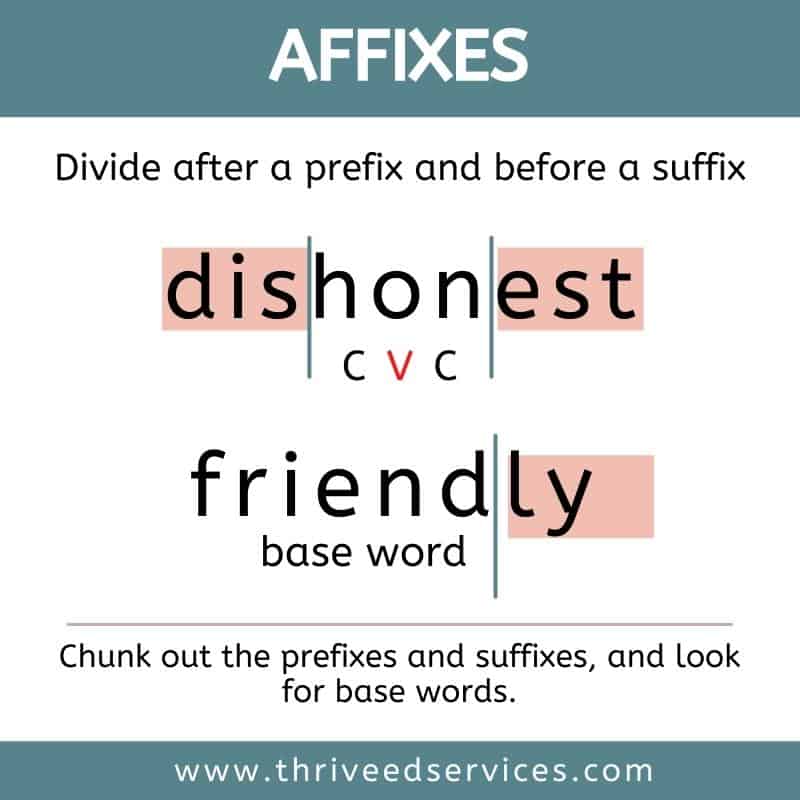
Strategies To Teach Syllabication Rules
Teach students to use vowels to identify syllables
Since one vowel sound = one syllable, the first thing students should do is identify the vowels. I always have my students draw a dot above each vowel. After that, I have them label every vowel and consonant by writing a V or C under each letter. Then they have to check if it’s a vowel team or silent e. At this point, they know exactly how many syllables a word has, even if they’re not sure where to split it yet.
Below is an example using the word student.
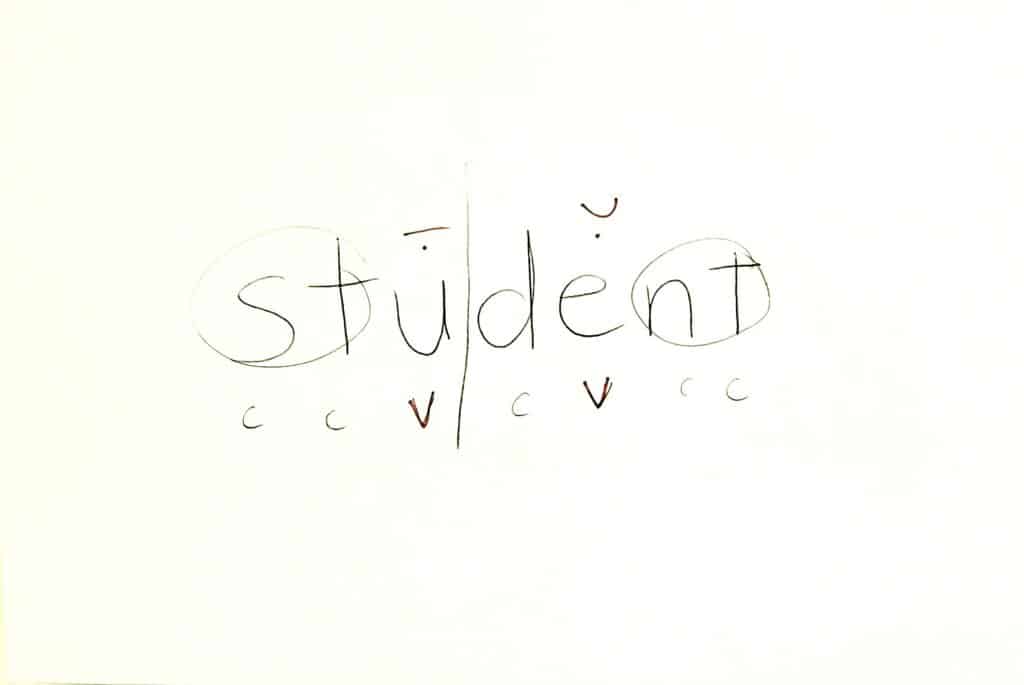
Teach students to look for patterns
At this point, students can look for patterns in the consonant and vowels. Students should look for vowel teams and magic e’s, digraphs and blends, then look for syllable patterns: VC, CV, VCCV, VCe, C+le, VCV, VV, Vr.
Teach base word families, prefixes, and suffixes
Students should also check for any base words, prefixes, and/or suffixes. Each base word or affix usually is its own syllable, but in some cases, they are not. Students can split these and try reading the word.
Teaching affixes daily and working with word family groups is a great way to address this area. Through consistent exposure and practice, students internalize these word parts and more quickly divide words into syllables.
Teach the different spelling patterns for each sound
It’s helpful if students know the options for spelling certain sounds, such as all the ways to pronounce the suffix -ed. This way when they are breaking up the word into syllable and sounding it out, they can accurately read a word.
A sound wall is a great way to teach all the spelling patterns for each sound. You can display each spelling pattern as students learn it and keep it up all year long as a reference. Read more about sound walls here.
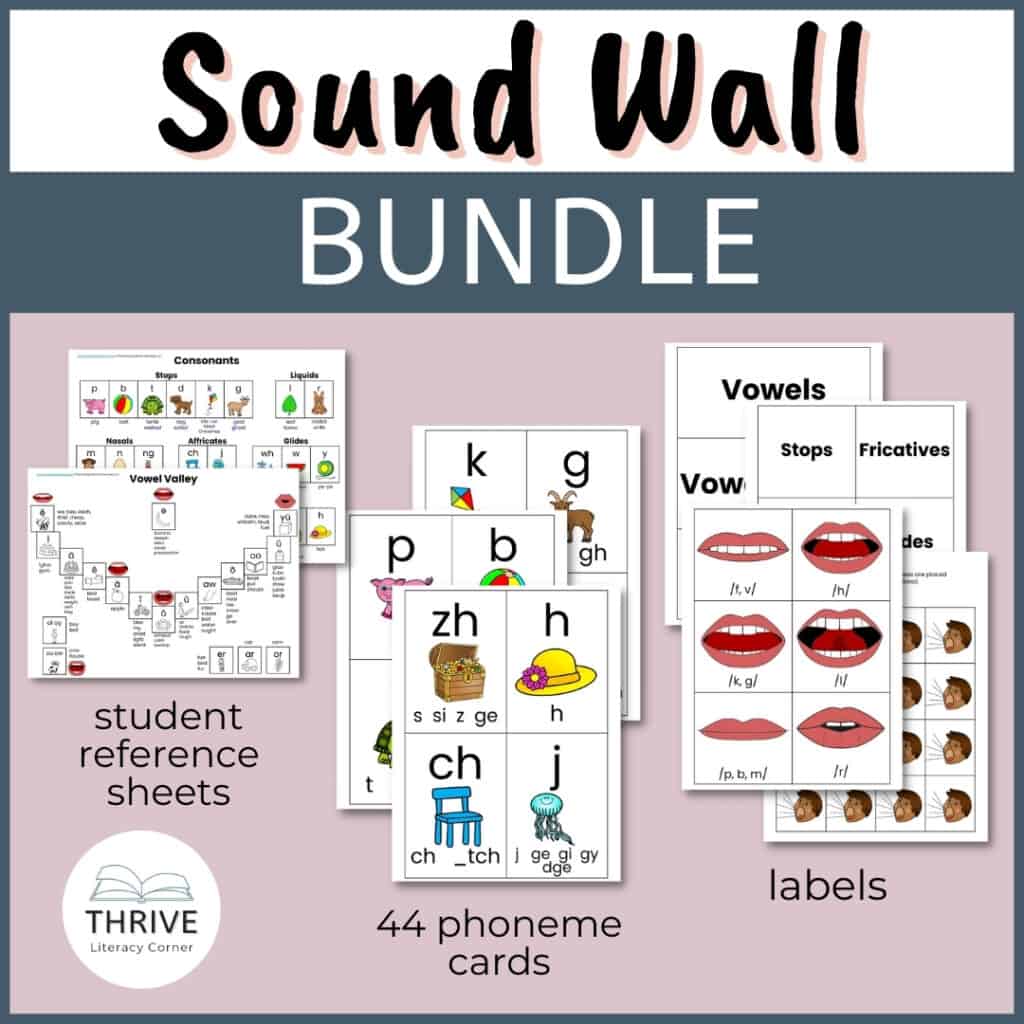
Syllable Activities For Teaching Syllable Separation
Start off with teaching the 6 syllable types, one at a time. I created a bundle of all my syllable division worksheets which you can check out below.

You can also download these syllable types reference posters by signing up for my email list below.
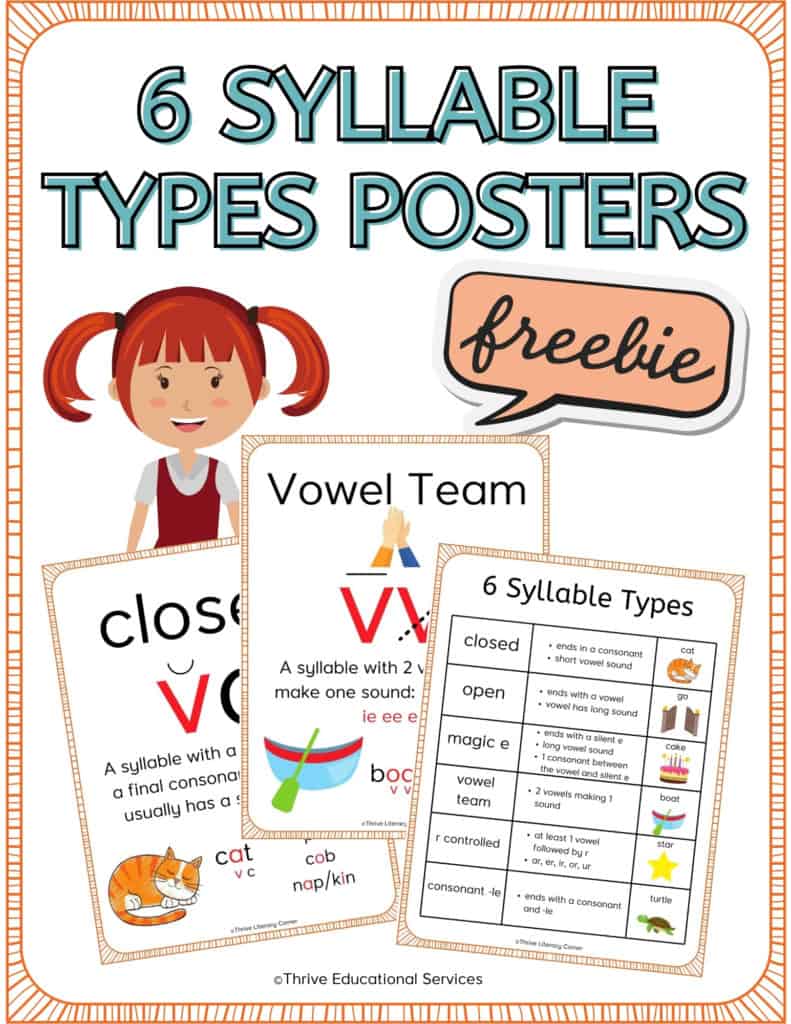
Diagram multisyllabic words
Whenever I am teaching syllabication, students must always follow the same procedure to diagram each word:
- Spot and dot the vowels
- Label the consonants and vowels underneath
- Look for patterns, affixes, and base words
- Split according to the rules
- Mark the vowels as long or short
- Read the word aloud
Below is an example, the same picture I used above to show how to mark the vowels. You can see the student placed a dot above both vowels, labeled each consonant and vowel, found blends, found where to split the word, then marked the vowels as long and short.

Cut words into syllables
The very first activity after teaching the syllable division pattern is to cut words up because the visual really helps struggling learners. I write a few words on index cards, have students diagram the words, then cut them along the division line. We later use these to sort syllables.
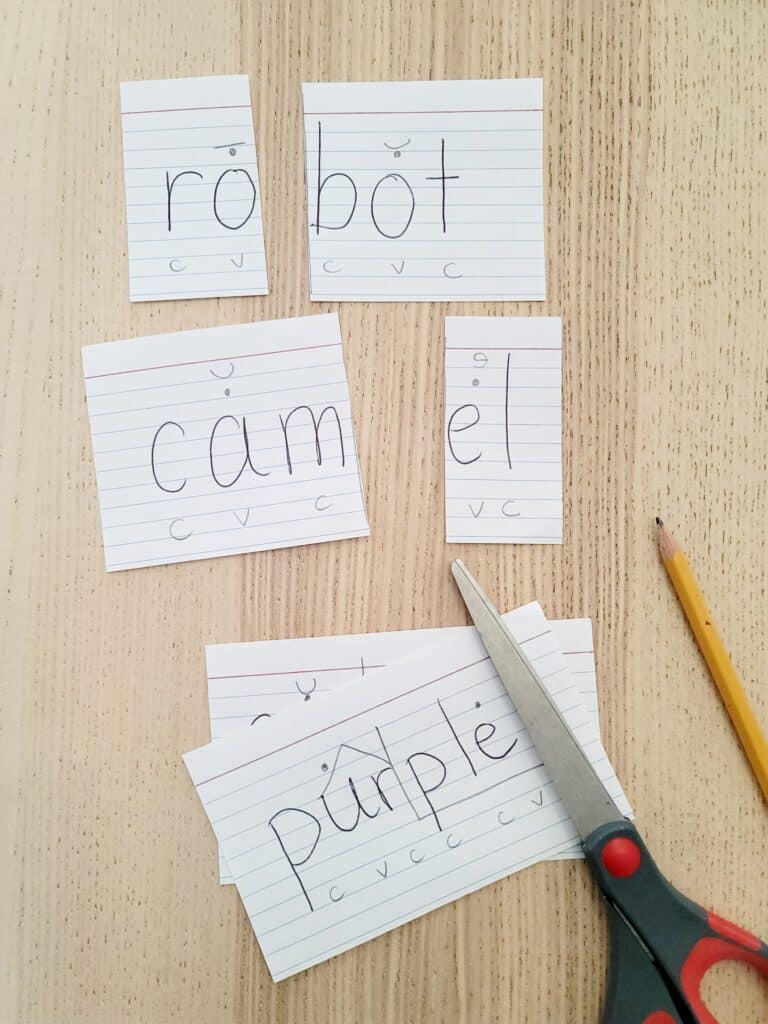
Sort syllables
There are tons of syllable sorting activities you can download and prepare, but I like to use the cut up syllables from the previous activity to sort syllables. You can sort into all the syllables types or just choose 2 to focus on as pictured below.
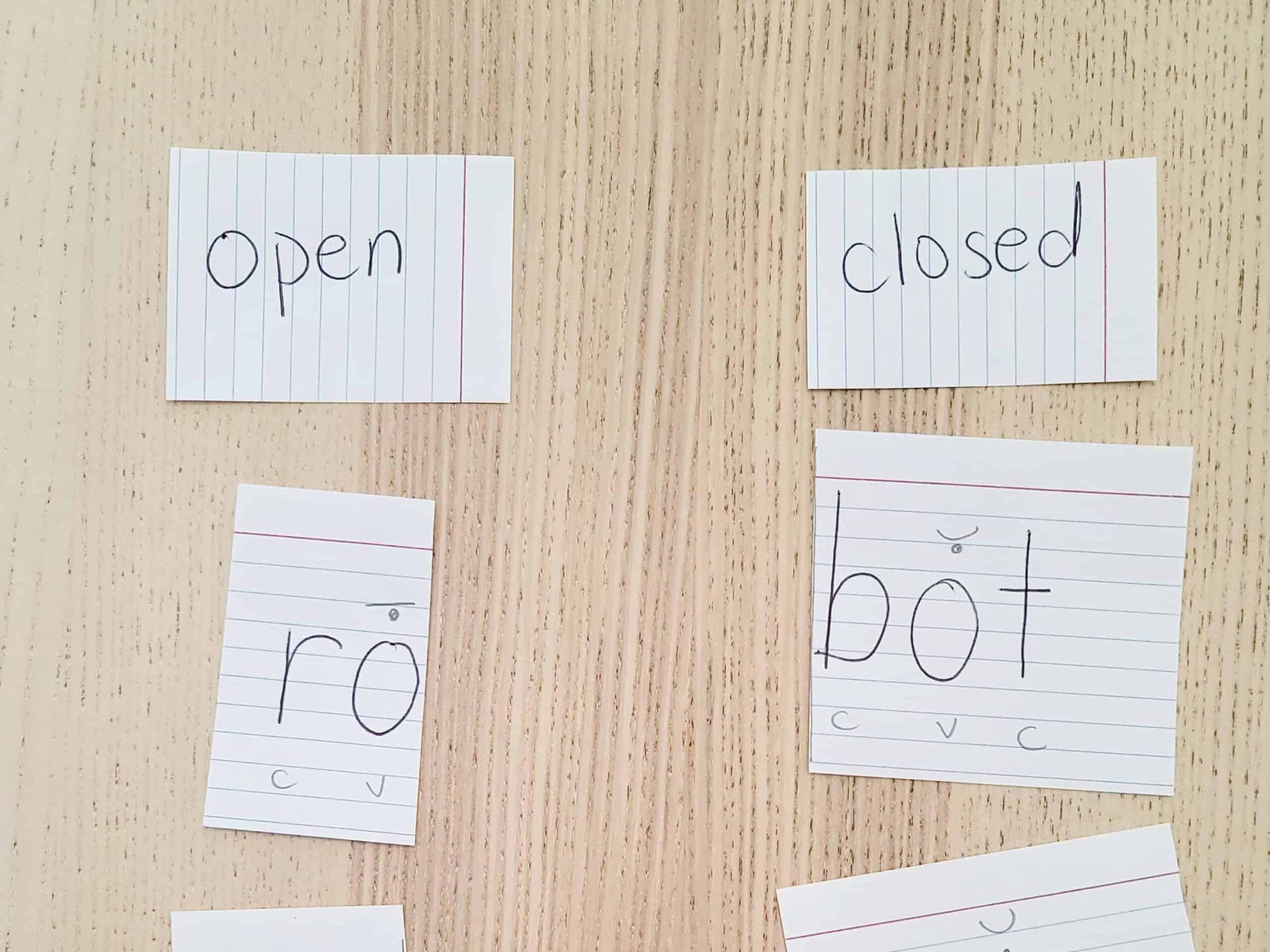
I also use a syllable and vowel pattern chart to sort syllables as I teach them. Each student has their own copy of this and fills it in as we learn each syllable.
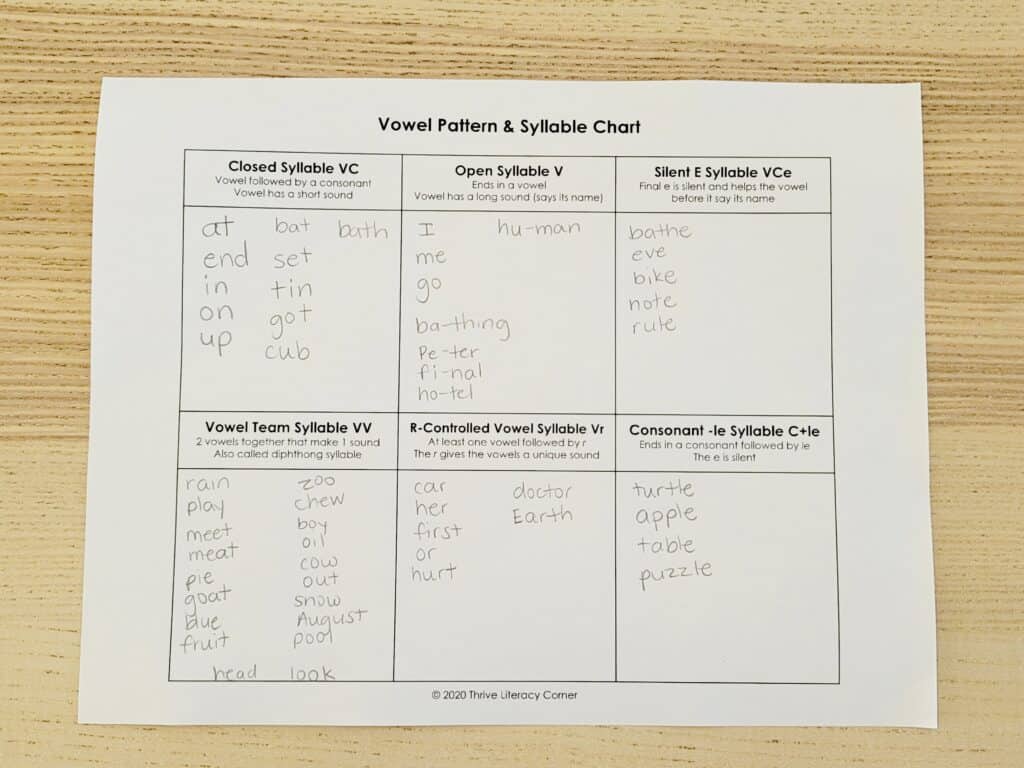
Syllable search
This is an easy activity you can do with any text, but a targeted decodable text is ideal. Simply ask students to read a passage and highlight all the words that have the target syllable. From here, students can create a list of the words they found and split them.
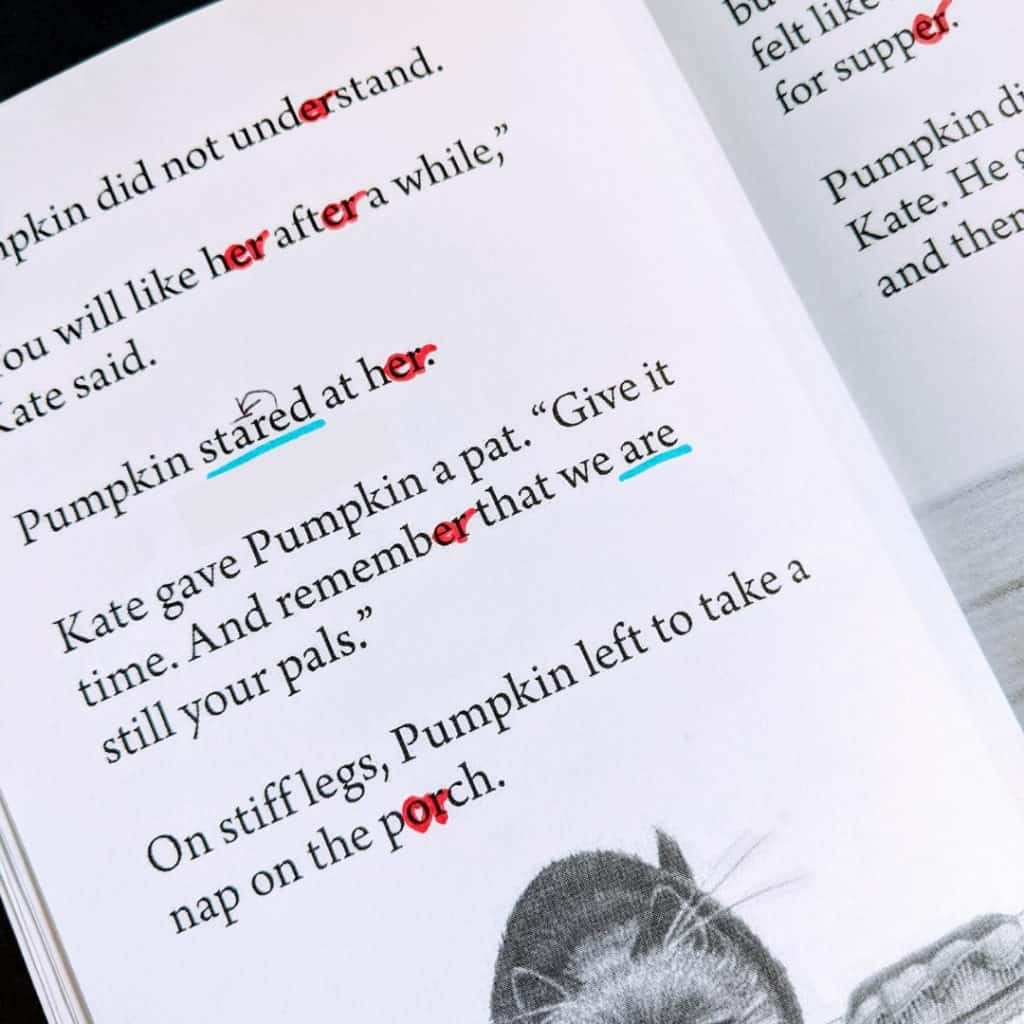
Conclusion
Syllable division rules help readers break words into smaller parts making reading the word easier on their brains. This means that they don’t have to work as hard when trying to figure out what word you’re saying or spelling because each syllable has its own meaning and breaks up the task of decoding letters in order one at a time for your brain. Try these activities next time you teach syllable division.
Sources:
- How To Teach Spelling by Laura Toby Rudginsky and Elizabeth C. Haskell
- Phonics and Spelling Through Phoneme-Grapheme Mapping by Katheryn E. S. Grace
- Structured Literacy Interventions: Teaching Students with Reading Difficulties, Grades K-6 by Louise Spear-Swerling
- Speech to Print: Language Essentials for Teachers by Louisa Cook Moats
Want to remember this? Save Syllable Division Rules: How To Divide Words Into Syllables to your favorite Pinterest board!
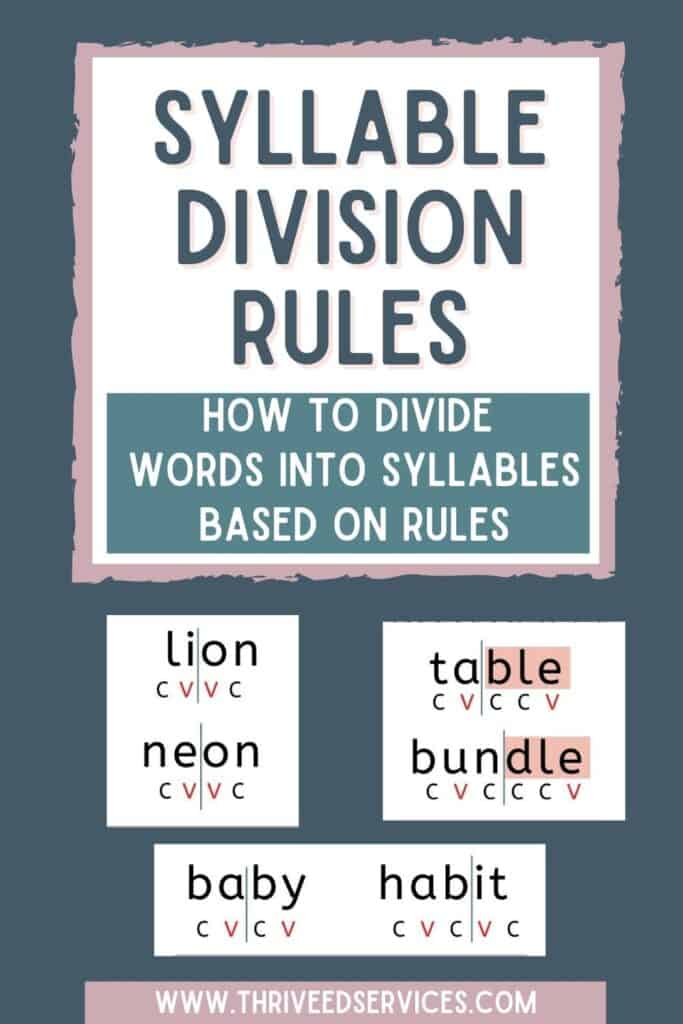
Delilah Orpi is the founder of Thrive Literacy Corner. She has a Bachelor’s degree in Special Education, a Master’s degree in TESOL, and is a member of the International Dyslexia Association. She is an experienced educator and literacy specialist trained in Orton Gillingham and Lindamood Bell. Delilah creates literacy resources for educators and parents and writes to create awareness about dyslexia and effective literacy instruction based on the science of reading.
How Many Syllables
Syllable Rules >> Syllabification Examples
Syllable Division Rules
- Separate prefixes and suffixes from root words.
- examples: pre-view, work-ing, re-do, end-less, & out-ing
- Are two (or more) consonants next to each other?
- Divide between the 1st and 2nd consonants.
- examples: buf-fet, des-sert, ob-ject, ber-ry, & pil-grim
- Never split 2 consonants that make only 1 sound when pronounced together and aren’t the same letter (i.e., ‘ff’).
- examples: th, sh, ph, th, ch, & wh
- Is the consonant surrounded by vowels?
- Does the vowel have a long sound? (Like the ‘i’ in line)
- Divide before the consonant.
- examples: ba-by, re-sult, i-vy, fro-zen, & Cu-pid
- Does the vowel have a short sound? (Like the ‘i’ in mill)
- Divide after the consonant.
- examples: met-al, riv-er, mod-el, val-ue, & rav-age
- Does the word end with ‘ckle’?
- Divide right before the ‘le.’
- examples: tack-le, freck-le, tick-le, & buck-le
- Does the word end with ‘le’ (not ‘ckle’)?
- Is the letter before the ‘le’ a consonant?
- Divide 1 letter before the ‘le.’
- examples: ap-ple, rum-ble, fa-ble, & ta-ble
- Is the letter before the ‘le’ a vowel?
- Do nothing.
- examples: ale, scale, sale, file, & tile
Fun Fact
A pangram is a sentence using
all
26 letters of the alphabet.
Syllable Rules >> Counting Syllables Examples
Examples
- little: lit — tle
- petal: pet — al
- turtle: tur — tle
- ankle: an — kle
- riddle: rid — dle
- arrow: ar — row
- nickel: nick — el
- cotton: cot — ton
- student: stu — dent
- teacher: teach — er
- children: chil — dren
- pottery: pot — ter — y
- learning: learn — ing
- textbook: text — book
- watching: watch — ing
- screaming: scream — ing
- misbehaving: mis — be — hav — ing
Download Article
Download Article
All words have at least one syllable. A syllable is a vowel sound that’s connected or unconnected to consonants that form a unit of pronunciation. For example, the word «banana» is broken up into three parts, or syllables, for each piece of sound you pronounce before you momentarily pause: ba-[pause]-na-[pause]-na. Knowing how to divide words into syllables can greatly help with your spelling and reading skills as well as your ability to pronounce words correctly.
List of Words
-
1
Clap your hands as you say a word. Try to form a steady beat for every individual sound you make.[1]
- For example, ba (clap) — na (clap) -na (clap). This word has three claps, one for every syllable.
- Words have a natural emphasis when you say them regularly. The word «banana» sounds like banana because it stresses the middle syllable. Coordinate your claps with the natural stresses and emphases of a word.
- Start with bigger words that you know have more than one syllable, like «hippopotamus.» The more syllables there are, the longer and more rhythmic your beat will be, making it easier to divide the word.
-
2
Use a metronome or Newton’s cradle to make a beat. Say a part of the word every time you hear a «click» noise.
- Try to be silent at the same times the metronome or Newton’s cradle is silent. Only say a syllable when you hear a click sound. This will help you split up a word into its smallest audible segments.
- This might be easier than clapping because your focus is mostly on saying words and not so much on creating a rhythm. You can also use your hands to tally the syllables in particularly long words.
- If using a metronome, pick a fast but steady tempo. Most hit songs fall into the 120 beats-per-minute (BPM) range,[2]
suggesting that maybe most people appreciate sound at this speed. Try setting your tempo to 120 bpm and saying words on tempo.
Advertisement
-
1
Write a word down on a piece of paper. Use big letters and leave some room between letters to separate syllables.
- Write the word in a blue. You will later be drawing vertical lines to separate syllables, which you can color in red. This will provide visual contrast and help you picture how words are broken up.
- Look at where the vowels fall in your word. Every syllable will have a vowel, but may not always have a consonant.[3]
-
2
Identify any prefix in a word. Prefixes are sets of letters added to the beginning of a word to give it a specific meaning.[4]
- For example, the word «play» is different than the word «replay.» «Play» means to show something once; «replay» means to show something again.
- Many prefixes are usually one syllable, for example rewind, predetermine, and postmortem.
- Some prefixes have more than 1 syllable. If your prefix has more than one vowel and the vowels are separated by consonants, it is more than one syllable. For example, «anti» is a prefix with two syllables. «Ant» is one syllable and «i» is the other.
- Prefixes with more than one vowel that are not separated by consonants most likely are only 1 syllable. For example, «eu» in «eulogy» is only 1 syllable.
-
3
Draw a line after the prefix of the word. Separate the prefix from the remaining letters in your word.
- For example, «re | wind.» Now you can start to see how your word is made up of smaller chunks of letters.
- For prefixes with more than one vowel, look at the where the vowels fall. If your prefix has more than one vowel and has consonants between them, draw a line after the first consonant that follows your first vowel. For example: «an | ti.»
- Many words don’t have prefixes. If your word doesn’t have a prefix, don’t worry about this step.
-
4
Identify any suffix of a word. Suffixes are like prefixes, but they are added to the end of the word to make them mean something different.[5]
- For example: «calculate» means something different than «calculator. Calculate is when you find the amount of something; calculator is a tool for helping you find that amount.
- Like prefixes, suffixes are usually one syllable but can sometimes be more than 1. Common suffixes include «s,» «ed,» and «ing,» as in «computers,» «computed,» and «computing.»
-
5
Draw a line before the suffix of a word. If your word has both a prefix and suffix, you should have two lines drawn in your word so far.
- For example: «re | wind | ing.»
- If your suffix has more than one vowel, follow the same rule as with prefixes. If vowels have consonants between them, draw a line after the first consonant that follows your first vowel. For example: flex | ib | le.
- Some words don’t have prefixes or suffixes. If your word does not have a suffix, do not draw a line.
-
6
Divide any compound words. If there are two separate words have been put together, draw a line between them.[6]
- For example: «tree | house» or «water | slide.»
-
7
Draw lines in the remaining chunks according to vowel placement. If you have a section of letters with multiple vowels that are separated by consonants, divide it so that there is at least one vowel in each segment.
- For example, «comput | ing» would be broken up into «com | put | ing.»
-
8
Say your word. Pause every time you get to a line. This should help you audibly separate your word into smaller chunks.
Advertisement
Add New Question
-
Question
How do I break down the word escoger?
es-co-ger
-
Question
Why is it ther-mom-e-ter and not ther-mo-me-ter?
The usual practice is to divide syllables after a consonant that follows a «short» vowel. In this case, the second «m» follows the «short o,» and so the division comes after the «m». Another example is «habit,» in which the division comes after the consonant «b» because the «a» is «short» (hab-it). However, in the word «basin,» the «a» is «long,» so the division comes before the consonant «s» (ba-sin).
-
Question
How do I divide the word «queue»?
Sherringford
Community Answer
The word «queue» is one syllable. Although it looks wrong, you can’t divide it any more than it already is.
See more answers
Ask a Question
200 characters left
Include your email address to get a message when this question is answered.
Submit
Advertisement
Video
-
Read the word out loud. This will help you syllabicate words on paper as well as say words correctly that you are unfamiliar with when reading. When in doubt on where to split a word into syllables, follow the common practice that an open-ended vowel, or a vowel at the end of a portion of sound, will say its long sound. A vowel that is closed off with a consonant will say its short sound.
-
Place the back of your hand under your chin for an easy way to determine syllables. Speak. Every time your jaw moves, it is a new syllable.
-
Government, for example, is 3 syllables.
Advertisement
References
About This Article
Article SummaryX
Learning how to divide words into syllables can help your spelling and reading skills as well as your ability to pronounce words correctly. To find the syllables in a word, try clapping your hands on each individual sound as you say the word. For example, if you’re working with the word “banana,” you’d clap on “ba,” “na,” and “na.” If you’re more of a visual learner, try writing the word down and drawing verticle lines to separate the syllables. Another way to identify syllables is to identify compound words and draw a line separating them. For instance, for the word «treehouse,» draw a line between «tree» and «house.» To learn how to use vowels to find syllable breaks, keep reading!
Did this summary help you?
Thanks to all authors for creating a page that has been read 520,231 times.
Reader Success Stories
-
Jennifer Vendettuoli
Sep 21, 2018
«My name is Jennifer. People often ask me if I spell my nickname Jen or Jenn. I spell it Jen because the rule is…» more
Did this article help you?
The Great Soviet Encyclopedia defines a syllable as «the minimum pronunciation (articulatory) unit of speech, consisting of one or more sounds that form a close phonetic unity on the basis of a single exhalation impulse.» This definition belongs to the outstanding Russian linguist V. Vinogradov. Despite the complexity of the definition, it is quite simple to divide the words of the Russian language into syllables.
It is necessary
Ability to make phonetic transcription of a word
Instructions
Step 1
Remember that syllable splitting is associated with the phonetic shell of the word, so first make a transcription (restore the sound of the word). For example, «window» — [ak-no], «turtle» — [chi-r’i-pa-ha], light — [sv’ie-tlo].
Step 2
Syllables are divided into closed (at the end of a consonant) and open (at the end of a vowel), and also highlight covered and uncovered syllables, depending on which sound the syllables begin with. For example, in the word «tumba» there are two syllables [tum-ba], both of them are covered, because begin with consonants, and in the word «food» [yi-da] the first syllable is uncovered, tk. starts with a vowel sound.
Step 3
Remember that syllable splitting is associated with the phonetic shell of the word, so first make a transcription (restore the sound of the word). For example, «window» — [ak-no], «turtle» — [chi-r’i-pa-ha], light — [sv’ie-tlo].
Step 4
There are complex cases of dividing words into syllables — how to divide into syllables if a word contains several consonants next to each other? The linguist Krivonosov in the methodological development of «Linguistics of the Text» reports that «the structure of the Russian word tends to an open syllable,» therefore, «the border between syllables should be drawn according to the vowel: Nevsky [n’e-fsk’iy], with-friend-zhs- state [sa-dru-zhy-stva | «.
Step 5
Syllables are divided into closed (at the end of a consonant) and open (at the end of a vowel), and also highlight covered and uncovered syllables, depending on which sound the syllables begin with. For example, in the word «tumba» there are two syllables [tum-ba], both of them are covered, because begin with consonants, and in the word «food» [yi-da] the first syllable is uncovered, tk. starts with a vowel sound.
Step 6
There are complex cases of dividing words into syllables — how to divide into syllables if a word contains several consonants next to each other? The linguist Krivonosov in the methodological development of «Linguistics of the Text» reports that «the structure of the Russian word tends to an open syllable,» therefore, «the border between syllables should be drawn according to the vowel: Nevsky [n’e-fsk’iy], with-friend-zhs- state [sa-dru-zhy-stva | «.
Popular by topic
Did you know that dividing words into syllables is one of the most powerful decoding strategies out there?
If your students are ready to read words with more than one syllable, then it’s time to start teaching syllable division rules!
When readers know the syllable division rules, it A) helps them successfully decode multisyllabic words and B) provides them with clues about the vowel sounds in multisyllabic words!
Knowing how to divide words into syllables gives your kids POWER to attack those longer words!
In today’s post, I’ll explain how to teach students to divide words into syllables!
…And I also have something to confess:
Despite being an English speaker, teacher, and avid reader, I did not know these rules until I’d already been teaching for years.
So if these rules are new to you, don’t sweat it! We’re all learning! All the time!
The 6 Syllable Types
Do you know the 6 syllable types? They are:
- Closed
- Open
- Vowel-Consonant-E (also known as Magic E or Silent E)
- Vowel Team
- R-Controlled
- Consonant-L-E
If you haven’t read my post that goes in-depth on these syllable types, you may want to read that first, and then come back to this post. My 6 syllable types post can be found HERE!
(And yes – there are a lot of terms and rules to remember when you’re teaching phonics. If you’d like a free PDF that has many different terms and rules in one place, grab this freebie!)
Finding the Number of Syllables in a Word
An important first step in dividing up a word into its syllables is knowing how many syllables the word has.
You may already know that 1 vowel sound = 1 syllable. If a word has 3 vowel sounds, for example, then it has 3 syllables.
(Notice that I’m saying vowel sounds, not actual vowels. The word “cupcake,” for example, technically has 3 vowels. But the e is silent. It only has two syllables because the vowel sounds we hear are the short u and the long a, 2 total vowel sounds.)
Syllable Division Patterns
There are only 6 syllable types, and there are even fewer syllable division patterns!
The syllable division patterns are as follows (V = vowel; C = consonant):
VC/CV
If you have two consonant sounds between two vowel sounds, divide the word between the consonant sounds.
In the word “sunset,” the vowel sounds are the short u and the short e. The two consonants in the middle, n and s, get divided up.
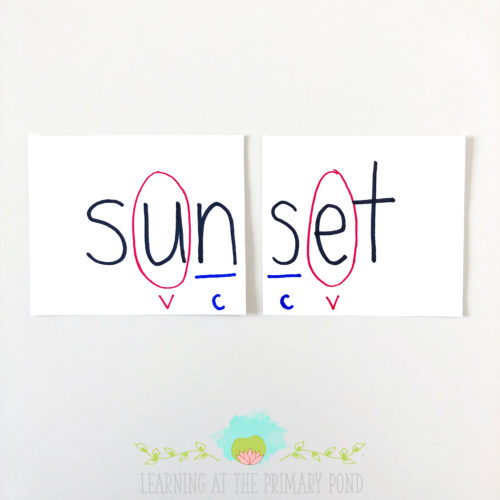
In the word “bathtub,” the vowel sounds are the short a and the short u. The two consonant SOUNDS in the middle are /th/ and /t/. The word gets divided up between the h and the second t.
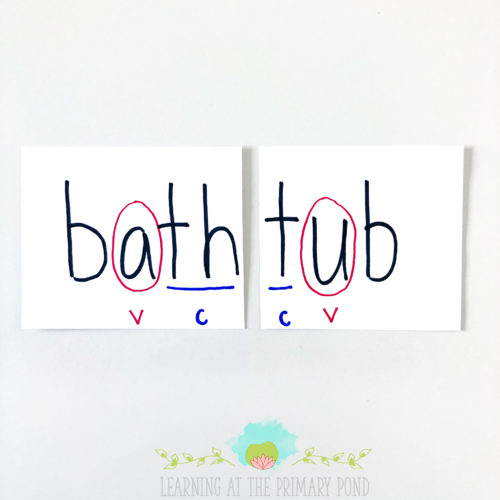
If there are 3 consonants between the vowels, rather than 2, there’s going to be a blend in there. The sounds that get blended together stay together in one syllable.
For example, in the word “complex,” we divide between the m and the p.
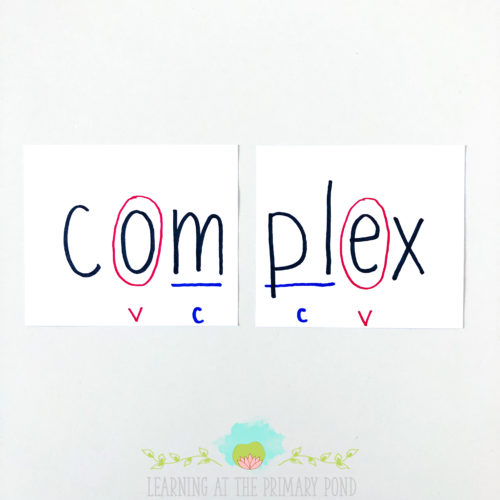
V/CV
Moving on…sometimes there’s just one consonant sound between the vowels, rather than 2.
If this is the case, the first syllable division rule that we try is V/CV (dividing up the word BEFORE the consonant).
For example, in the word “robot,” we divide up the word before the b. This creates an open syllable, “ro,” that ends in a vowel. As a result, the o in that syllable is a long o.
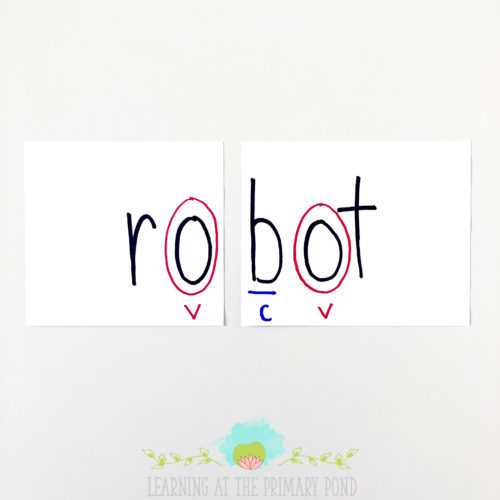
VC/V
However, sometimes the V/CV division rule doesn’t work. This is where it gets a little tricky.
If we try the V/CV rule but discover that it creates an open first syllable that should NOT be open (aka it should not have a long vowel sound), then we have to revert to the VC/V pattern.
For example, let’s think about the word “comet.” It’s pronounced with a short o at the beginning, right? It’s not CO-met. But if we were to apply the V/CV division pattern, that would make the o sound long. Instead, we have to revert to VC/V in order to reflect the fact that the o has the short o sound.
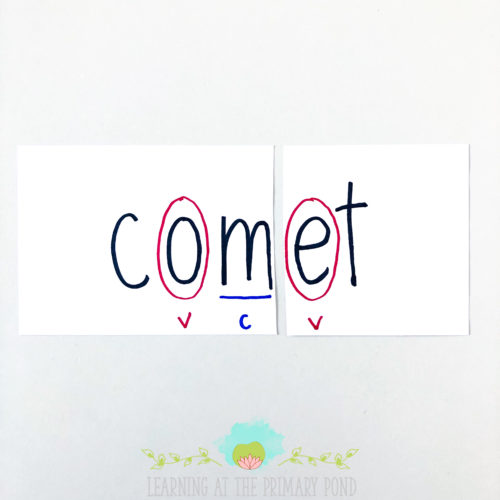
Another example is the word “seven:”
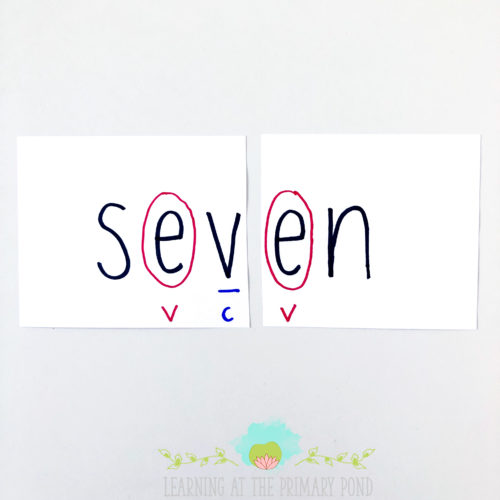
V/V
Last but not least, we have the V/V syllable division rule! When there are two vowels next to each other that do NOT work as a team, then we divide the word between those two separate vowel sounds.
For example, we divide the word “diet” between the i and the e:
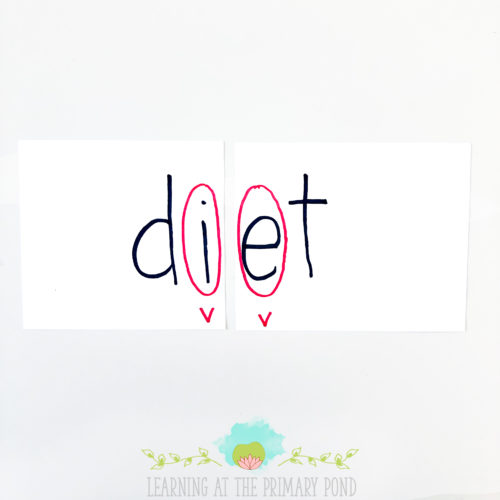
However, in a word like “coat,” we do NOT divide between the o and the a. There is only one vowel sound, the long o. Therefore, it’s a one-syllable word, and the o and the a work together to make a single sound. They cannot be divided up.
Tips for Teaching Syllable Division Rules to Students
Okay, so….that’s not too bad, right? Once you understand the four syllable division patterns, then you can teach them to your students!
As you probably noticed from the photos in this post, I have my students circle and label the vowels with red, underline and label the consonants with blue, and then cut or draw a line to divide the words. (Scroll back up through the photos in this post and have a closer look at what I did, if that helps.)
Here’s the procedure:
- Look at the word. Circle the vowel sounds with red.
- Underline the consonants BETWEEN the vowels (don’t worry about the other consonants).
- Determine which syllable division rule (VC/CV, V/CV, VC/V, or V/V) applies. (Students may have to attempt to read the word to choose between V/CV and VC/V.)
- Cut or mark the word accordingly.
- Read the word.
You can also have students code the syllable types after Step #3 (closed, open, VCE, vowel team, r-controlled, or CLE—read more about the syllable types HERE!)
When we’re learning about syllable division and syllable types, we use strips of paper. Students can copy a word I write on the board (or I prepare the word strips for them ahead of time).
I don’t read the word to them, because the purpose of the division exercise is to get them to break up the word and read it.
Once they’ve copied the word, then we go through Steps 1-5 listed above, and students can cut the word in half.
The ultimate goal of this exercise is to get students to break up multisyllabic words as they read. So, as a bridge between this activity and reading, we use whiteboards or sticky notes to divide up tricky words they encounter in texts.
If I’m working one-on-one with a student and he/she comes to a tricky word, we can write it on a small whiteboard and then break it up.
If students are working on their own, they can write a tricky word on a sticky note, divide it up, read it, and then continue reading.
This does slow down the reading process a little, but I’m telling you…kids feel SO powerful when they can break up words and determine what types of syllables they have. This process also makes it easier for students to figure out the vowel sounds in a word too.
When to Teach This Stuff
You might be wondering, “When should I teach these rules? At what developmental stage or grade level are these appropriate?”
When to teach the VC/CV rule:
Whenever kids have mastered CVC words, they can read 2-syllable words!
Simple compound words are a great place to start. You’ll want to use words like “sunset” and “pigpen” that are 2 CVC words “put together.” At this point, you can teach students the VC/CV rule. You can also explain that both of the syllables in those words are closed and have short vowels.
I don’t normally teach this in Kindergarten, but if I have more advanced students who are truly proficient with CVC words, then it makes sense to give them “access” to these simple 2-syllable words.
Of course, if you give students words with consonant digraphs or blends in between, then it becomes a little more complicated—early first grade may be a better time for those more complicated VC/CV words.
When to teach the V/CV and VC/V rules:
I teach the V/CV rule first, because we always try the V/CV pattern before reverting to VC/V.
You can teach this rule once students know about the long vowel sounds.
They don’t need to have completely mastered long vowels and all their spelling patterns. But they at least need to understand the concepts of open and closed syllables (and how short and long vowels relate to open and closed syllables).
When we’re working on the V/CV rule, I intentionally only give them practice words that follow that rule.
After they understand the V/CV rule, then I explain that sometimes we have to use the VC/V rule instead.
I then give them VC/V words to practice.
Finally, I give them mixed sets of words where they have to choose between V/CV and VC/V.
When to teach the V/V rules:
I wait to teach V/V until students really understand vowel teams and diphthongs.
If students don’t understand vowel teams, then they may try to divide up words like “train” into two syllables, between the a and the i. If they don’t understand diphthongs, they may try to divide up words like “loud” into two syllables.
Once they know the vowel teams and diphthongs, however, they’re more likely to recognize that words like “fluent” have two vowel sounds, not one, and we divide up the word accordingly (flu/ent).
Conclusions
This was a lot of info, right?! And it’s a lot to figure out and teach on your own – if you don’t have lesson plans and materials for it. Because unfortunately, many phonics and reading programs don’t cover this stuff!
If you’d like to make teaching this EASY and FUN for you and your students, check out my step-by-step guide to teaching all the syllable division rules and syllable types.
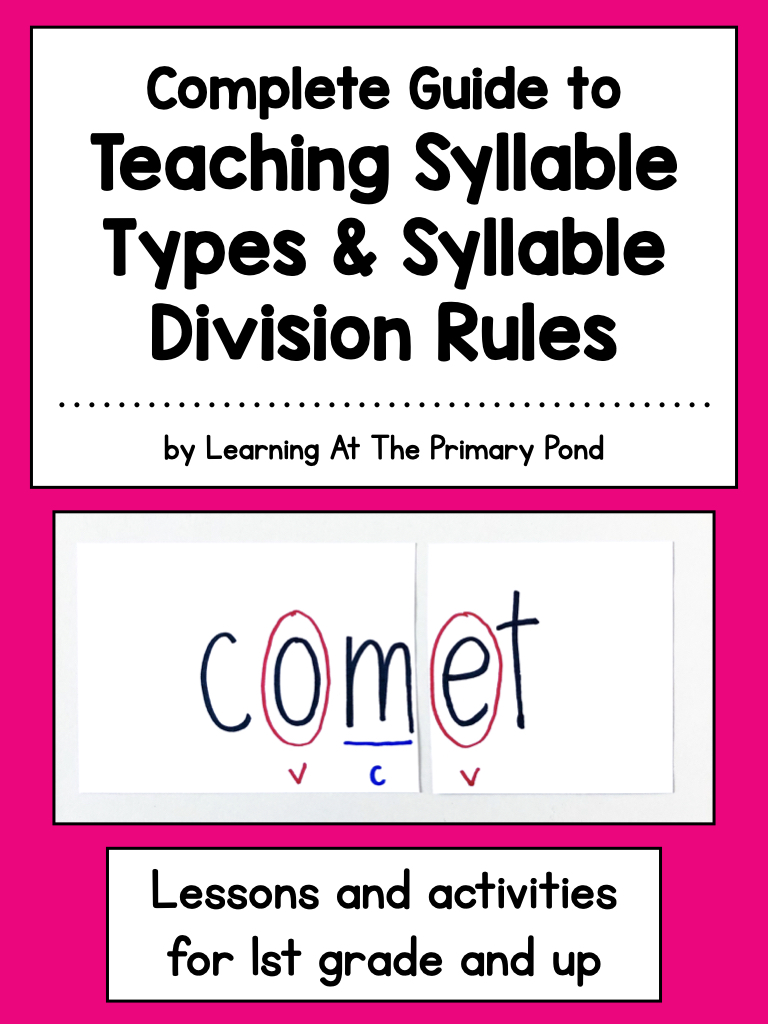
I designed this resource to fit perfectly into any phonics program. (However, if you’re using my phonics program, From Sounds to Spelling, you won’t need this resource because we cover this info within the program.)
You set the pace for how quickly you progress through these lessons! 1st grade teachers may spread them out throughout the entire school year, while 2nd grade and up may progress more quickly. Here’s page 1 of the table of contents (this is only half of the lessons):
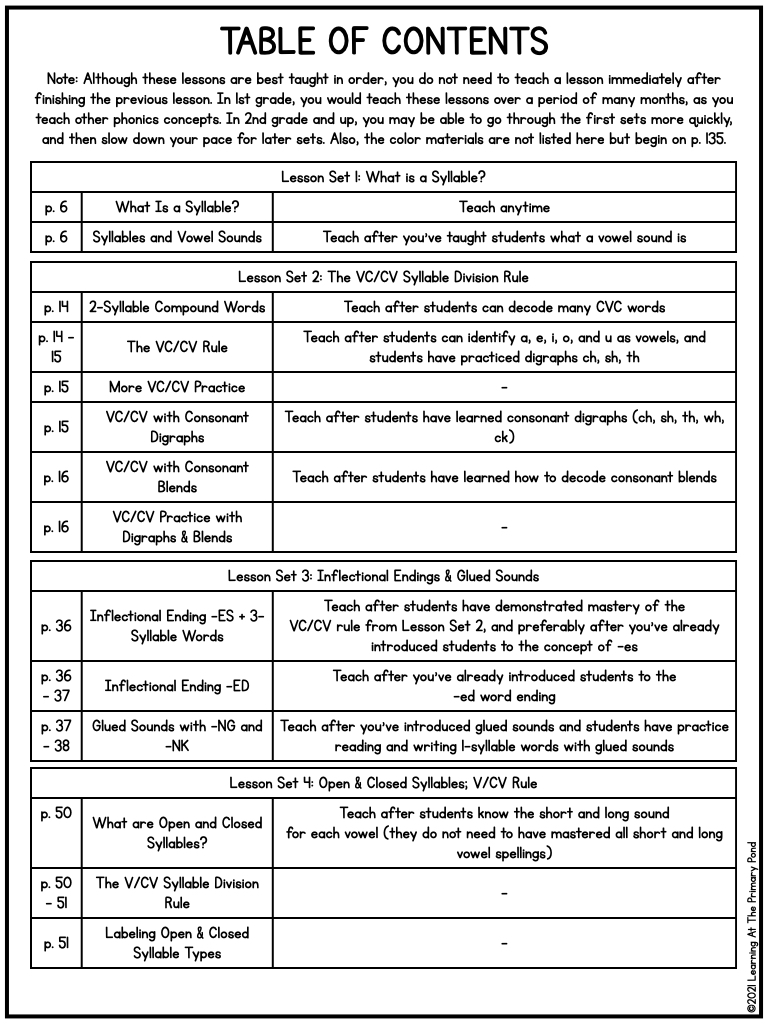
Here’s what a lesson plan looks like:
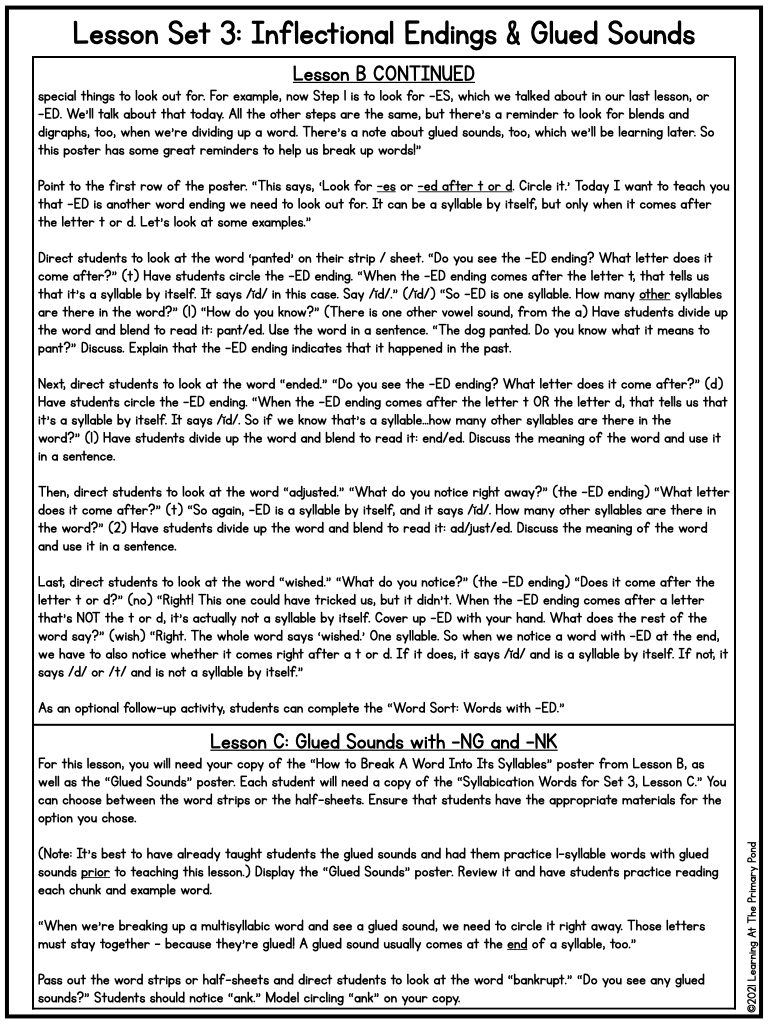
Also included are words to practice dividing, plus lots of hands-on games!
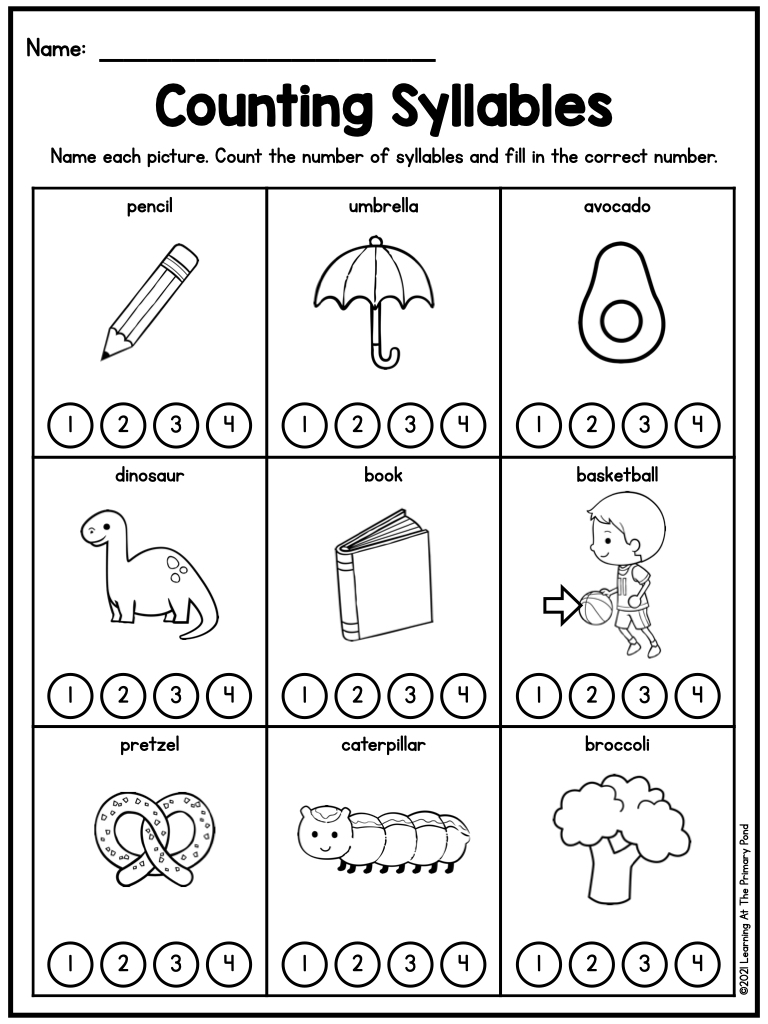

Everything is done for you, so you won’t have to invest time or energy in figuring all this out on your own and creating lessons!
However, if you already feel confident in teaching syllable division and have plenty of materials for it, you may just need a few practice activities for your students. If that’s the case, my digital practice games might be a better fit.
These activities give your students practice with dividing words up into syllables AND identifying syllable types. The games include audio directions that explain the syllable types and division rules!


I hope these resources are helpful to you! You can also pin this blog post to your Pinterest account so you can come back to it later:
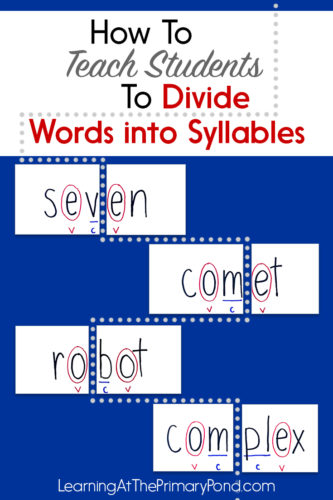
Happy teaching!

